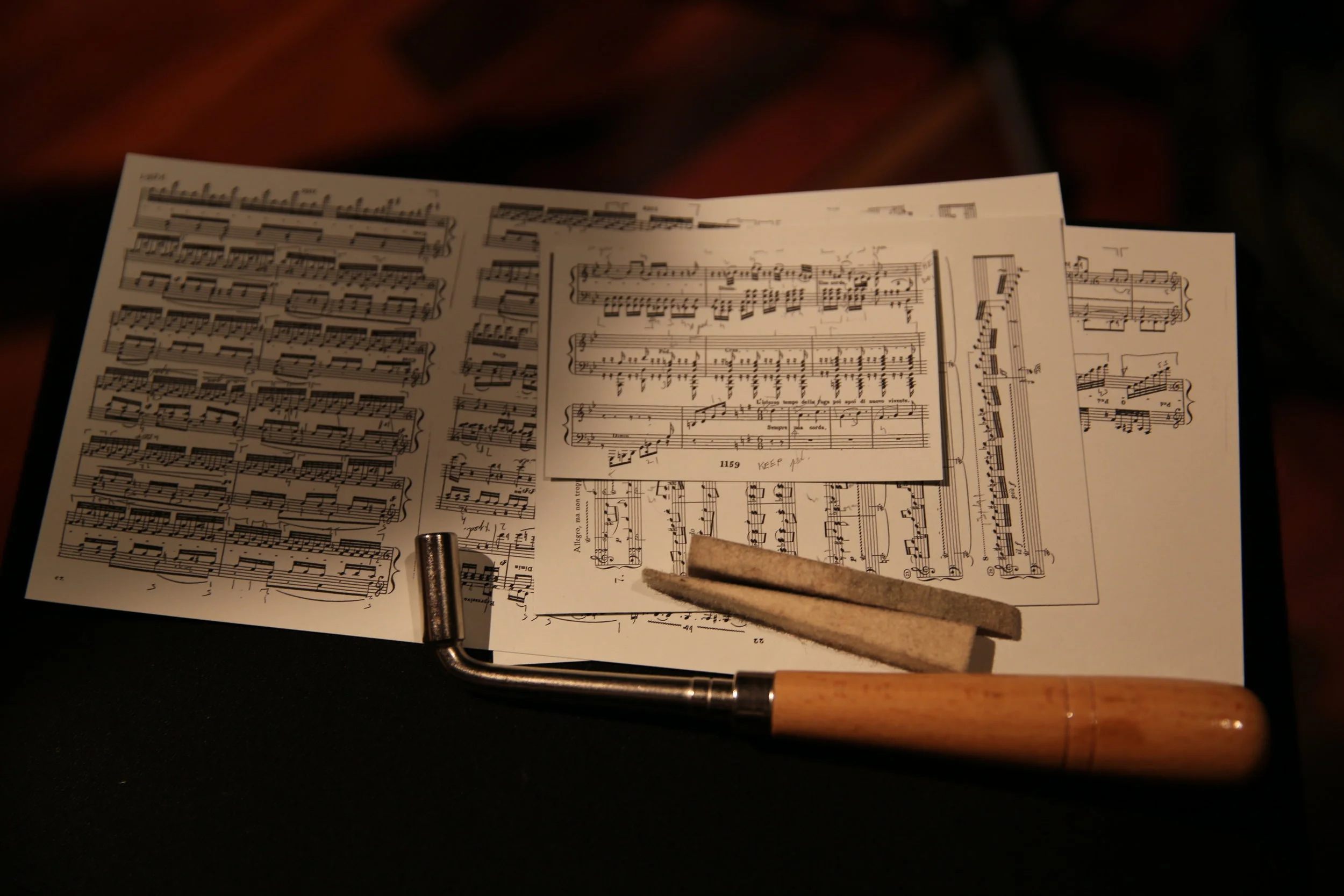Think clavichord. A rectangular box, with strings running perpendicular to the player from left to right, a clavichord is the keyboard par excellence if you value playing in all privacy, or even solitude. Its lid (also rectangular and straight up) directs the tangent-generated vibrations backward—that is, back to you as a player. It is as if you face a mirror, into which, through your fingers, you can project your musical thoughts, which are sent back to your ears quasi instantaneously. Your vibrations may ideally be shared with one or possibly two listeners seated next to you, most logically at your right-hand side, which is, first, where there’s any room at all for someone to sit close to the instrument, and second, where the clavichord’s soundboard lives, making that privileged listener’s seat also the acoustical “sweet spot,” in fact more so than for the player herself (who, seated at the keyboard on the left, would hear the sounds, and especially the treble, mostly from her right).
By analogy, it is this intensely interiorizing private performing and/or listening setting that we aimed to recreate for our recordings of Beethoven’s late/last piano sonatas Opus 109, 110, and 111. We wished to truly empathize with an ever-experimenting Beethoven, who puts his head in his Gehörmaschine, vibrations from his beloved Broadwood reflecting back to him, from the longest bass string extending the line of his left arm all the way to the tail of the piano in front, to the shortest treble string on his right, within half a meter from his right ear. (In this sense, the vision of a “backward-projecting” Broadwood is potentially superior to the acoustic reality of a clavichord, since it is the player who sits at the most privileged or sweet spot, at the center between bass and treble.) We imagined Beethoven “really getting into it,” fantasizing at his English piano and composing a trilogy of piano sonatas—the first such “opus” in a long time. (We have to go two decades back all the way to Opus 31, when Beethoven was thirty-one.)
First, we built a replica of Beethoven’s Broadwood. But we needed to also replicate this crucial idea of “backward-projection,” positioning the performer (and by extension the listener, through the performer’s ears) front and center of the acoustic experience. To this purpose, we designed and built various prototypes of machines or lids. Eventually, we settled on what we dubbed the “flexible backward-projecting lid,” which to our ears yielded the best possible balance between focalizing sound (a priority for Beethoven’s Gehörmaschine) and diffusing it (both softening the blow on the well-hearing player’s ears and opening up the soundscape to possible listeners or microphones around or at the back of the player).
But we’d like you to be the judge. We recorded six fragments (two from each sonata) in five different acoustical “conditions” (to adopt a statistical term used for this kind of comparative experiment). Fragments and conditions combine to a total of thirty sound files, which may here be assessed and compared. What exactly changes in the quality of sound when playing without a lid versus playing with a lid, or from playing with our “horn” hearing machine versus our “box”? Do these various conditions significantly affect the way we experience Beethoven’s music? Do they affect the pianist’s performance?
We recorded these fragments after three days of working only with the flexible backward-projecting lid: that is the sound that made it onto the CD and those are the performances that have been truly polished through multiple takes. But for our experiment, within each of the five set-ups, Tom performed the six fragments as a single event, without any rehearsal to adjust to the new condition and without re-takes. There’s one exception: after hearing the result of playing with no lid at all, resulting in a maximum degree of sound diffusion, Tom wished to play another version of Fragment 1 where he could “compensate” for what, upon listening to the recorded sound, he had perceived as too diffused a soundscape. By consciously exerting sharper finger attacks, Tom wished to add focus to his playing, although (and this is important) this apparent diffuseness had apparently not bothered him during the playing itself—at least not to the extent of feeling compelled to change his manner of playing.
Microphone placement during our experiments remained the same as during the CD-recording—that is, positioned just behind the player, reflecting a “backward-listening” perspective. Also here, there’s one exception. For “regular lid” option we turned the piano by 90 degrees, so that the microphones (themselves unchanged) would record it from the side—the idea here being to offer you (the listener) a conventional point of reference (our “control condition,” if you will), before moving on to the unfamiliar “backward-listening” examples (the “experimental conditions”). Thus, the comparative listening exercise below always starts with the regular lid (or the normal way of listening to the piano on recording today) as a point of reference.
We invite you to compare and assess the sonic results. You may do so by fragment or by condition. Members of our research team have been asked to do the same. We plan to share their observations here soon. As yet another layer to this project, then, you will be able to compare and contrast the observations by different professionals: those of the Tonmeister, the acoustician, the instrument maker, the pianist.



